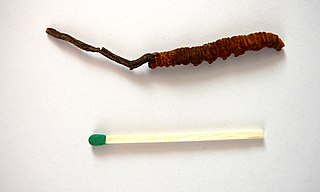
Ophiocordyceps sinensis, known colloquially as caterpillar fungus, is an entomopathogenic fungus in the family Ophiocordycipitaceae. It is mainly found in the meadows above 3,500 metres (11,500 ft) on the Tibetan Plateau in Tibet and the Himalayan regions of Bhutan, India, and Nepal. It parasitizes larvae of ghost moths and produces a fruiting body which is valued in traditional Chinese medicine as an aphrodisiac. Caterpillar fungus contains the compound cordycepin, an adenosine derivative. However, the fruiting bodies harvested in nature usually contain high amounts of arsenic and other heavy metals, so they are potentially toxic and sales have been strictly regulated by China's State Administration for Market Regulation since 2016.
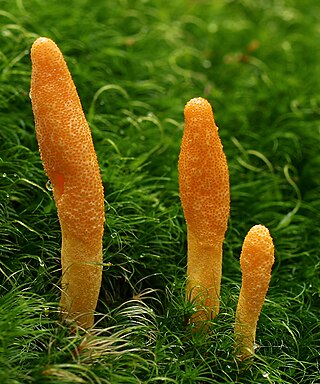
Cordyceps is a genus of ascomycete fungi that includes about 600 worldwide species. Diverse variants of cordyceps have had more than 1,500 years of use in Chinese medicine. Most Cordyceps species are endoparasitoids, parasitic mainly on insects and other arthropods ; a few are parasitic on other fungi.
Thitarodes is a genus of moths of the family Hepialidae. In English Thitarodes is known as "ghost moth". They are found in eastern Asia. The majority are restricted to the Tibetan Plateau. Often in Chinese entomological nomenclature Thitarodes is still referred to as Hepialus, although the name was changed back in 1968. Furthermore, some authors use incorrectly the term "bat moth" which is a bad translation of the Chinese term for ghost moth.
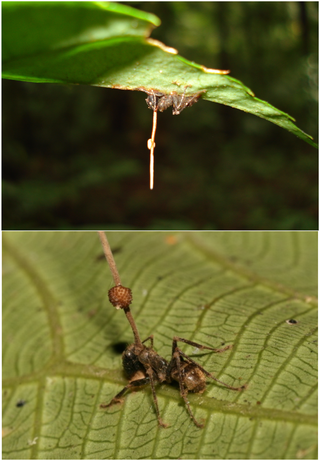
Ophiocordyceps unilateralis, commonly known as zombie-ant fungus, is an insect-pathogenic fungus, discovered by the British naturalist Alfred Russel Wallace in 1859, and currently found predominantly in tropical forest ecosystems. O. unilateralis infects ants of the tribe Camponotini, with the full pathogenesis being characterized by alteration of the behavioral patterns of the infected ant. Infected hosts leave their canopy nests and foraging trails for the forest floor, an area with a temperature and humidity suitable for fungal growth; they then use their mandibles to attach themselves to a major vein on the underside of a leaf, where the host remains after its eventual death. The process, leading up to mortality, takes 4–10 days, and includes a reproductive stage where fruiting bodies grow from the ant's head, rupturing to release the fungus's spores. O. unilateralis is, in turn, also susceptible to fungal infection itself, an occurrence that can limit its impact on ant populations, which has otherwise been known to devastate ant colonies.

Ophiocordyceps is a genus of fungi within the family Ophiocordycipitaceae. The widespread genus, first described scientifically by British mycologist Tom Petch in 1931, contains about 140 species that grow on insects. Anamorphic genera that correspond with Ophiocordyceps species are Hirsutella, Hymenostilbe, Isaria, Paraisaria, and Syngliocladium.
Podonectria is a genus in the monotypic Podonectriaceae family of fungi. They are parasitic fungus on scale insects, other fungi, or on substrates that had previously colonized by other fungi.
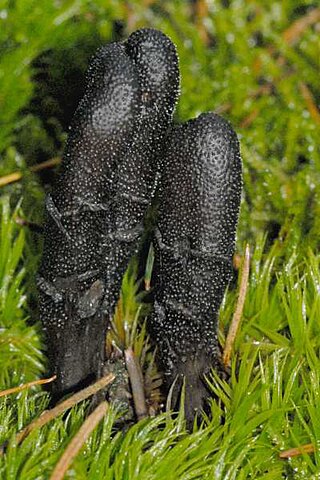
Tolypocladium is a genus of fungi within the family Ophiocordycipitaceae. It includes species that are parasites of other fungi, insect pathogens, rotifer pathogens and soil inhabiting species with uncertain ecological roles. Tolypocladium was originally circumscribed as a genus containing anamorphic fungi. It was later determined that some Cordyceps-like teleomorphic fungi were the teleomorphs of Tolypocladium species. These species were considered to belong in the genus Cordyceps until molecular phylogenetics studies found these species to be more closely related to Ophiocordyceps and were considered to belong in that genus before they were transferred to the new genus Elaphocordyceps by Sung and colleagues in 2007. However, under the ICN's 2011 "one fungus, one name" principle, fungi can not have different names for their anamorphic and teleomorphic stages if they are found to be the same taxon. Quandt and colleagues formally synonymized Tolypocladium and Elaphocordyceps in 2014. Quandt and colleagues also synonymized the anamorphic genus Chaunopycnis with Tolypocladium. The immunosuppressant drug ciclosporin was originally isolated from Tolypocladium inflatum, and has since been found in other species of Tolypocladium, some of which were formerly placed in Chaunopycnis.
Ophiocordyceps camponoti-balzani is a species of fungus that parasitizes insect hosts of the order Hymenoptera, primarily ants. It was first isolated from Viçosa, Minas Gerais, on Camponotus balzani. This species was formerly thought to be Ophiocordyceps unilateralis, which has subsequently been divided into four species. O. camponoti-balzani infects ants, and eventually kills the hosts after they move to an ideal location for the fungus to spread its spores. This has earned the species names such as “zombie fungus”, given the fungus has been observed to cause its hosts to bite hard into the substrate it stands on, so that the fungus can then stably grow.

Dumbletonius unimaculata is a species of moth of the family Hepialidae. It is endemic to New Zealand. This species is host to the vegetable caterpillar fungus Ophiocordyceps robertsii.

Ophiocordyceps nutans is an entomopathogenic fungus belonging to the order Hypocreales (Ascomycota) in the family Ophiocordycipitaceae. O. nutans only parasitizes Hemipterans, namely stinkbugs. In Korea, O. nutans is one of the most common species of Cordyceps. O. nutans, as well as other Cordyceps species, are mainly classified morphologically by their colour, fruit body shape, and host insect species. Stinkbugs cause considerable damage to agriculture and forestry, and the anamorph of O. nutans, Hymenostilbe nutans, is a potential selective biological control agent against the stinkbugs.

Ophiocordyceps macroacicularis is an entomopathogenic fungus belonging to the order Hypocreales (Ascomycota) in the family Ophiocordycipitaceae, which parasitize moth larvae. It produces superficial, oval perithecia at the apex of its stroma, and also multiseptate ascospores, while producing Hirsutella-type anamorphs on growth culture media. They are particularly distinguished by the size and shape of their stromata.
Ophiocordyceps arborescens is an entomopathogenic fungus belonging to the order Hypocreales (Ascomycota) in the family Ophiocordycipitaceae. It produces superficial, oval perithecia at the apex of its stroma, and also multiseptate ascospores, while producing Hirsutella-type anamorphs on growth culture media. They are particularly distinguished by the shape and size of their stroma.
Ophiocordyceps camponoti-novogranadensis is a species of fungus that parasitizes insect hosts, in particular members of the order Hymenoptera. It was first isolated from Parque Estadual de Itacolomi in Ouro Preto, at an altitude of 1,000 metres (3,300 ft), on Camponotus novogranadensis.
Ophiocordyceps camponoti-melanotici is a species of fungus that parasitizes insect hosts, in particular members of the order Hymenoptera. It was first isolated from Viçosa, Minas Gerais, on Camponotus melanoticus.
Ophiocordyceps camponoti-rufipedis is a species of fungus that parasitizes insect hosts, in particular members of the order Hymenoptera. It was first isolated from Viçosa, Minas Gerais, at an altitude of 700 metres (2,300 ft) on Camponotus rufipes.

Ophiocordyceps formicarum is an entomopathogenic fungus belonging to the order Hypocreales (Ascomycota) in the family Ophiocordycipitaceae. The fungus was first described by mycologist George S. Kobayashi in 1939 as a species of Cordyceps. Originally found in Japan growing on an adult Hercules ant, it was reported from Guizhou, China, in 2003. It was transferred to the new genus Ophiocordyceps in 2007 when the family Cordycipitaceae was reorganized. A technique has been developed to grow the fungus in an agar growth medium supplemented with yeast extract, inosine, and glucose.

Ophiocordyceps sphecocephala is a species of parasitic fungus. It is entomopathogenic, meaning it grows within insects, particularly wasps of the genera Polistes, Tachytes, and Vespa. It has been reported across the Americas and China.
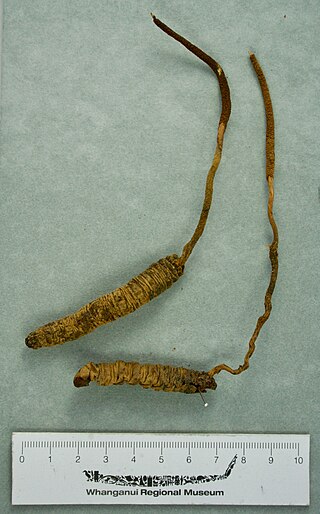
Ophiocordyceps robertsii, known in New Zealand as vegetable caterpillar is an entomopathogenic fungus belonging to the order Hypocreales (Ascomycota) in the family Ophiocordycipitaceae. It invades the caterpillars of leaf-litter dwelling moths and turns them into fungal mummies, sending up a fruiting spike above the forest floor to shed its spores. Caterpillars eat the spores whilst feeding on leaf litter to complete the fungal life cycle. Evidence of this fungus can be seen when small brown stems push through the forest floor: underneath will be the dried remains of the host caterpillar. This species was first thought by Europeans to be a worm or caterpillar that burrowed from the top of a tree to the roots, where it exited and then grew a shoot of the plant out of its head. It was the first fungus provided with a binomial name from New Zealand.

Tzeanania is a monotypic genus of fungi established in 2018. It is the only genus in the family Tzeananiaceae and contains the single species Tzeanania taiwanensis. The species is a parasite which grows on fruiting bodies of the fungus Ophiocordyceps macroacicularis, which is itself a parasite of moth larvae. So far it is only known from one collection which was made in Taiwan.
Thitarodes shambalaensis is a species of moth of the family Hepialidae. It was described by Zhengyang Wang, along with Hailing Zhuang, Min Wang, and Naomi E. Pierce in 2019, and is known from Sichuan, China from the Tibetan Plateau, where it was found on the Yanzigou glacial valley, Mt. Gongga. It was differentiated as a new species using morphological and genetic evidence, including genome-wide SNP analysis and CO1 phylogeny. Notably, this species is a host for the caterpillar fungus Ophiocordyceps sinensis, which is economically important for its use in traditional herbal medicine. This fungus is in decline due to overharvesting and climate change. Species in the genus Thitarodes are largely unknown due to logistical difficulties in collecting adult, male specimens, correct identification of their genitalia, and lack of accessible holotypes.










